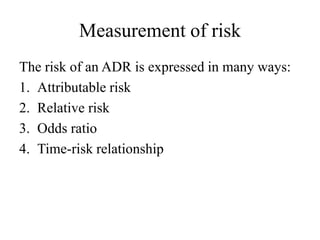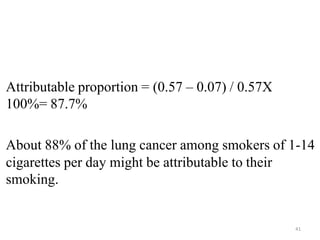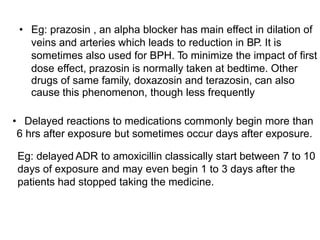Concept f risk
- 1. CONCEPT OF RISK IN PHARMACOEPIDEMIOLOGY Dr. Yuva Sri Sai Anumula Assistant Professor Department of pharmacy practice
- 2. • Epidemiology determine the relationship or association between a given exposure and frequency of disease in population. • Epidemiology does not determine the cause of a disease in a given individual.
- 3. • Risk is the likelihood or the probability of experiencing some type of harm, or losing something that one values. • Risk factors are variables or characteristics (biological - genetic disorder/ageing, environmental-air/water pollution/ passive smoking or psychosocial- workload/deadlines) associated with an individual that make it more likely that he or she, as opposed to another person randomly selected from the population, will develop a problem. CONCEPT OF RISK
- 4. RISK FACTORS: • Exists before a disorder or problem; • Maybe time – limited or may continue over time; • Can derive from the individual, the family, the community, institutions or the general environment; and • Can play a causal role or be a marker for a problem (BRAC) CHARACTERISTICS OF RISKS: 1. Risk is not certain. • Risk is based on probability. Therefore, not everyone who is exposed to a risk condition or factor will have an adverse outcome. Risk factors are “linked to” and “associated with” negative outcomes. • E.g. psychosocial outcomes v/s biological outcomes • Teratogenic drug – thalidomide, environmental toxin – lead
- 5. 2.Risk is a relative concept. • Risk factors range from those that are only markers to minimally harmful situations to those that are markers to life – threatening situations. • (Social continuum of risk/personal risk continuum) • Risk is not a neutral concept. It involves determining what are acceptable or unacceptable consequences. • Risk factors work together over time to influence the likelihood of a negative outcome. • The longer the exposure to risk factors, the greater the likelihood the health problem will occur. • Risk Identification – Exist as a social context. The identification of risk will be partially based upon their values, biases, experience and knowledge.
- 6. RELUCTANTLY ASSUMED RISK RISK PURSUED AS OPPORTUNITY RISK FOR WHICH NO CHOICE FREELYACCEPTED RISK Personal risk continuum.
- 7. Flow of Risk in Epidemiology: TRUE RISK PHARMACOEPIDEMIOLOGICAL CONSIDERATIONS STATISTICAL CONSIDERATIONS (Sampling, models, etc) (Bias, confounding etc) MEASURED ESTIMATED RISK
- 8. Risk in Pharmacoepidemiology: • Health research involves the estimation of risk. • In the case of drug related research, it is important to understand the concept of risk. • It is the probability of developing an outcome when exposed to a drug. • A drug is approved for human use only after measuring the risks and benefits associated with it. • HCP/Pharmacists should know the magnitude and frequency of the risk involved in the drug in use. • Each drug outcome has its own risk. • It is a probability and depends on a variety of factors like age, sex, physical conditions, food habits, other diseases, other medicines, kinetics of drugs etc.
- 9. Measures of association: • The key to epidemiological analysis is comparison. • Ameasure of association quantifies the relation ship between the exposure and disease among the comparison groups. 8
- 10. Measurement of risk The risk of an ADR is expressed in many ways: 1. Attributable risk 2. Relative risk 3. Odds ratio 4. Time-risk relationship
- 11. Attributable risk • Useful approach to express the magnitude of problems also called as the risk difference or excess risk • It is the difference between the risk in the exposed group and the baseline risk in unexposed population • Thus, it is the risk in excess of the baseline risk that may be attributed to exposure to the drug.
- 12. Mostly calculated in Cohort Studies, where individuals are assembled on exposure status and followed over a period of time. Investigators count the occurrence of the diseases. The Cohort is then subdivided by the level of exposure and the frequency of disease is compared between subgroups. Is a measure of the public health impact of a causative factor.
- 13. The calculation of this measure assumes that occurrence of disease in the unexposed group represent the baseline or expected risk for that disease.
- 14. It assumes that if the risk of disease in the exposed group is higher than the risk in the unexposed group, the difference can be attributed to the exposure.
- 15. The attributable proportion is the amount of the disease in the exposed group attributable to the exposure. 7
- 17. One is considered exposed and another unexposed. AR = R - Rexposed non-exposed where R is the rate of the outcome of the interest or the Incidence. Attributable Risk = Incidence in exposed – Incidence in unexposed %AR = 100 * R – Rexposed non-exposed R exposed
- 18. Example Astudy of smoking and lung cancer, the lung cancer mortality rate among nonsmokers was 0.07 per 1,000 persons per year. The lung cancer mortality rate among who smoked 1-14 cigarettes per day was 0.57 lung cancer deaths per 1,000 persons per year. Calculate the attributable proportion? 40
- 19. Attributable proportion = (0.57 – 0.07) / 0.57X 100%= 87.7% About 88% of the lung cancer among smokers of 1-14 cigarettes per day might be attributable to their smoking. 41
- 20. RELATIVE RISK Relative risk or risk ratio (RR) is the ratio of the probability of an event occurring ( eg:developing of anADR to a drug) in an exposed group to the probability of the event occurring in non- exposed group. (OR) • Compares the risk of a health event among one group with the risk among another group. Includes 2 features: i. A comparison of risk between two “exposure” puts risks in context , and ii. “exposure” is ensured by having proper denominators for each group representing the exposure
- 21. Risk Ratio (RR)= Risk of disease in group of primary interest Risk of disease in comparison group 11
- 23. RR = incidence in exposed Incidence in non-exposed It is a ratio of two risks, the risk of the outcome/event in the treated group compared with the outcome in those not exposed(control group). RR = Proportion of events in experimental group/proportion of events in control group. RR above 1 indicates treatment/exposure is associated with th outcome and below 1 means that the treatment is negatively associated with the outcome.
- 24. When the rate in the exposed group is equal to the rate in the comparison group RR will be equal to 1. An RR of 2 means that the rate in the exposed group is twice that in the non-exposed group. An RR of 0.5 means that the rate in the exposed persons is half that of non-exposed persons.
- 25. RR of more than RR of 1.0 1.0RR less than 1.0 Indicates a decrease Indicates identical Indicates anrisk for the exposed risk among the two groups. increase risk for the group in the numerator group. Indicating that perhaps exposure actually protects against disease occurrence. usually the exposed group. 12
- 26. Example In outbreak of T.B among prison inmates in South Carolina in 1999, 28 of 157 inmates residing on the east wing of the dormitory developed T.B, compared with 4 of 137 inmates residing on the west wing. 14
- 27. T.B + T.B - Total a=28 b=129 a + b=157East Wing West Wing Total c= 4 d=133 c + d=137 a+c=32 b+d= 262 a+ b+ c+ d=294 Risk of T.B among East Wing residents= 28/157 X100= 17.8% Risk of T.B among West Wing residents=4/137X100= 2.9% RR= 17.8/2.9= 6.1 The inmates who resided in the East wing of the dormitory were 6.1 times as likely to develop T.B as those who resided in the West wing. 15
- 28. Example In an outbreak of varicella in Oregon in 2002, varicella was diagnosed in 18 of 152 vaccinated children compared with 3 of 7 unvaccinated children. Calculate the risk ratio..? 16
- 29. Varicella + Varicella - Total 152 7 Vaccinated Unvaccinated Total 18 3 134 4 21 138 159 Risk of varicella among vaccinated children= 18/152 X100=11.8% Risk of varicella among unvaccinated children= 3/7X100= 42.9% RR=11.8/42.9=0.28 The vaccinated children were only approximately as one fourth to develop varicella 17 as were unvaccinated children.
- 30. • Relative risk and odds ratio are important as measures of the strength of association – Important for deriving causal inference. • Attributable risk is a measure of how much disease risk is attributed to a certain exposure – Useful in determining how much disease can be prevented. 42
- 31. Relative risk is valuable in etiologic studies of disease. Attributable risk is useful for Public Health guidelines and planning. 43
- 32. ODDS RATIO
- 33. • Is another measure of association that quantifies the relation ship between an exposure with two categories and health problem. • In a case-control study the RR is called an odds ratio (OR).
- 34. In statistics, an odds of an event is the ratio of: the probability that the event WILL occur to the probability that the event will NOT occur
- 35. In simpler term, an odds of an event can be calculated as: Number of events divided by number of non-events 23
- 36. 24 ODDS RATIO IN COHORT STUDIES:
- 37. 25 ODDS RATIO IN CASE-CONTROL STUDIES:
- 38. Example Disease+ Disease- 1900 Total 2000 8000 10000 Exposed 100 Not Exposed 80 Total 180 7920 9820 OD= 100X7920 / 1900X80 = 5.2 26
- 39. Example A case control study was conducted in Hamad Hospital to compare 35 lung cancer cases to controls to determine the associated factors related to lung cancer. Out of 117 subjects in the sample, 88 were daily smokers. Only two cases were found to be nonsmokers. Calculate the Odds Ratio and interpret it. ? 28
- 40. Cases Controls Total Lung Cancer Without Lung Cancer Daily Smokers Nonsmokers Total 33 2 55 27 82 88 29 35 117 Odds Ratio = 33X 27 / 2X55 = 8.1 Daily Smokers showed risk of having lung cancer 8.1 times that of nonsmokers. 29
- 41. TIME RISK RELATIONSHIP: • The outcome of an exposure to a drug is related to the time. • It is also true with risks associated with medicines. • There is always a time related association of risk in pharmacoepidemiology. • Certain events like anaphylactic reactions happen immediately after taking an injection while certain other risk events occur after days or months or even years. .
- 42. • Eg: prazosin , an alpha blocker has main effect in dilation of veins and arteries which leads to reduction in BP. It is sometimes also used for BPH. To minimize the impact of first dose effect, prazosin is normally taken at bedtime. Other drugs of same family, doxazosin and terazosin, can also cause this phenomenon, though less frequently • Delayed reactions to medications commonly begin more than 6 hrs after exposure but sometimes occur days after exposure. Eg: delayed ADR to amoxicillin classically start between 7 to 10 days of exposure and may even begin 1 to 3 days after the patients had stopped taking the medicine.
- 43. • Medications that cause delayed reactions include heparin, quinine, sulphonamides, vancomycin, gold compounds, beta lactam antibiotics and NSAIDs. • Lomustine is an anticancer drug used in different types of cancer which has an adverse effect of producing leucopenia that occurs 6 weeks after the dose. • The above mentioned aspects of medicine demonstrate that the exposure time must always be considered and the risk should be expressed as a function of time wherever possible in pharmacoepidemiology.










































